Chapter 8: Powering the Future: Solar Energy
Content:
I. Background
II. Why Use Solar
III. Solar Components
IV. Other Types of Solar Power
V. Solar Process Flow
VI. Incorporating PV System Into Your Home
VII. Solar Energy Consumption and Storage
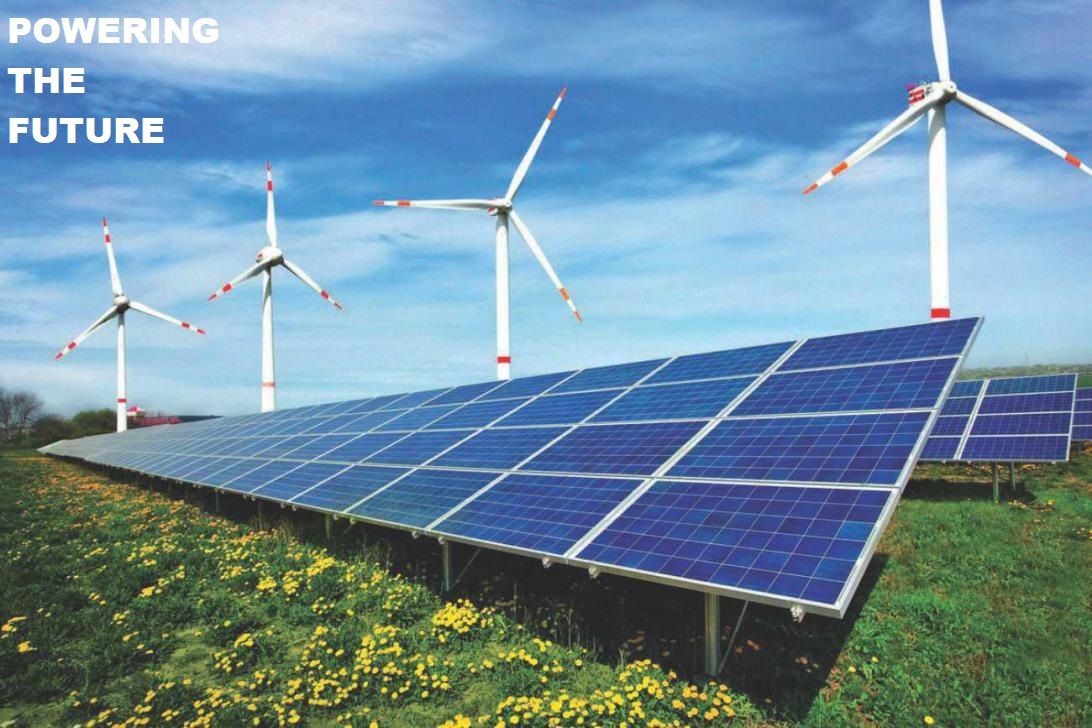
I. Background
Solar electric systems are popular choice among renewable energy options due to the relatively low maintenance requirements and the long lifetime of many of the system components. Because there are no moving parts, and thus, little chance of mechanical failure, most solar electric systems will continue to produce power for 30 years or more.
How does it work?
- Solar panel works by allowing photons, or particles of light, to knock electrons free from atoms, generating a flow of electricity.
- Solar panels comprise of many smaller units called Photo-voltaic cells
- Each Photo-voltaic cell is basically sandwich made up of two slices of semiconducting material, usually silicon, the same stuff used in microelectronics
- To work, photo voltaic cell need to establish an electric field, much like a magnetic field, which occurs due to opposite poles, an electric field occurs when opposite charges are separated.
- To get this field, manufacturers “dope” silicon with other materials, giving each slice of the sandwich a positive or negative electrical charge Specifically, they seed phosphorous into the top of the layer of silicon, which adds extra electrons, with a negative electrode (charge), to that layer.
- Meanwhile, the bottom layer gets a dose of boron, which results in fewer electrons, or a positive electrode (charge). -
This all adds up to an electric field at the junction between the silicon layers. Then, when a photon of sunlight knocks an electron free, the electric field will push that electron out of the silicon junction - A couple of other components of the cell turn these electrons into usable power. Metal conducive plates on the sides of the cell collect the electrons and transfer them to wires, at that point, the electrons can flow like any other source of electricity.
II. Why Use Solar?
Solar energy is the power provided by the sun, harnessed through technology called photovoltaic (PV) cells, which turn sunlight directly into electricity.
1. Environmetal-Friendly
- Unlike conventional power, solar produces no harmful emissions that hurt the environment. It’s a clean, renewable process that uses the most natural of all resources: the sun.
2. Cost Effective
- The cost for a solar system, on the other hand, remains the same. If you choose to lease or finance your system, then you have a set, minimal monthly payment that replaces your electricity bill. If you purchase your panels in full, from then on your energy cost becomes $0.
3. Durable
- Solar panels have no moving parts, and so are not damaged easily. This lowers the chance for an interruption in service.
4. Solid Investment
- Solar energy, on the other hand, will save you money from your energy bill each month. The investment that you make in solar, will add its exact property value–or more–to your home, should you decide to sell it later on.
- Marketplace to buy/sell your energy credits powered by the Blockchain (next chapter..)
III. Solar Components:
Solar panels typically made of:
1. Silicon crystal slices (solar cells, glass, a polymer backing, and aluminum framing)
- Solar panels have voltage ratings (12 or 24 volts, are generally preferred for off grid systems with battery banks.
- Less common nominal voltages (18. 42, and 60), these modules are typically used in-grid applications to accommodate the working of grid-tied inverters.
2. Solar Panel or PV module Mounting systems
- These systems are typically made of aluminum
- It is important to design and pour the cement foundation properly for any pole mount.

3. Junction/ Combiner Box
- Essential part of most solar electric systems, it is an electrical enclosure which allows multiple of solar panels to be combined in parallel
- For example, if you want to wire together two 12-volt panels for your 12 volt system, you will wire each panels output directly to terminals inside the combiner box.
- From the combiner box, you can then run just one positive and one negative wire to the next system component, the charge controller.
4. Solar Charge Controllers
- Regulates the amount of current the PV modules feed into a battery bank.
- Main function is to prevent overcharging of the batteries and block battery bank current from leaking back into the PV array at night or on cloudy days, draining the battery bank.
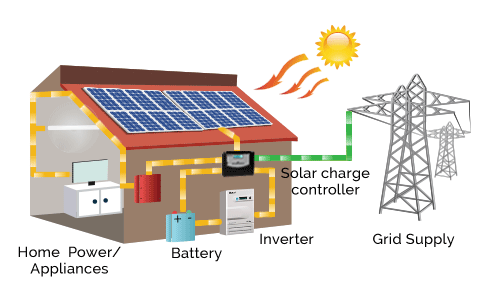
5. Batteries
- Chemically store electrical energy in renewable energy systems, 3 types of most common to the RE systems:
I. Flooded lead-Acid batteries (FLA)
a. Most cost-effective variety
b. Involves monitoring, adding water occasionally.
c. FLA batteries vent hydrogen under heavy charging so they must be stored in a ventilated enclosure
ii. Sealed absorbed Glass mat batteries (AGM)
a.Don’t require maintenance
iii.Sealed gel cell batteries
a. Most expensive amongst the 3 batteries
6. Solar Inverters
- Inverter takes DC from batteries turn into AC, which is used to run most common electrical loads
- Some inverters have integrated AC chargers, so that they can use AC power from the grid to charge the batteries during periods of low sun
- Inverters integrated AC chargers can also be used in conjunction with fossil fuel based generators for battery charging or running very large loads
7. DC and AC disconnects
- The disconnects are used by service personnel or authorized persons to stop power from a renewable energy system reaching the inverter.
- Disconnection prevents the current being produced from going beyond the disconnect point to a downed utility grid or damaged component
- Homeowners or authorized personnel can use disconnects to de-energize a system for maintenance or service
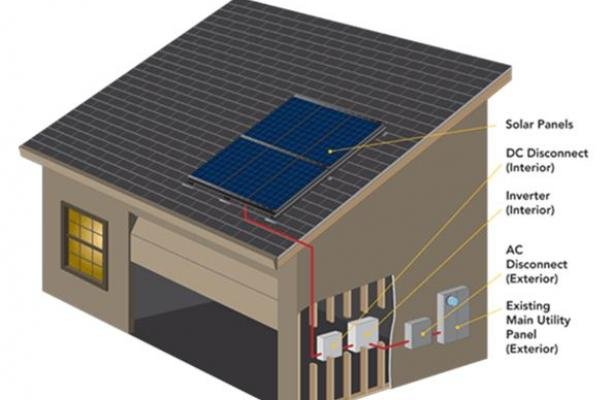
IV. Other types of Solar Power technology
1. Solar Thermal
- Solar thermal technology uses the sun’s energy, rather than fossil fuels, to generate low-cost, environmentally friendly thermal energy.
- This energy is used to heat water or other fluids, and can also power solar cooling systems. Solar thermal systems differ from solar photovoltaic (PV) systems, which generate electricity rather than heat

2. Concentrated Solar power (CSP)
- Concentrate the suns energy using reflective devices such as troughs or mirror panels to produce heat that is then used to generate electricity
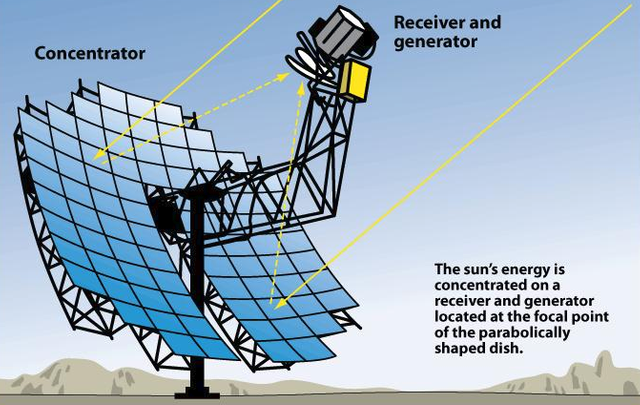
3. Transpired solar collectors (solar walls)
- Use solar energy to preheat ventilation air for a building
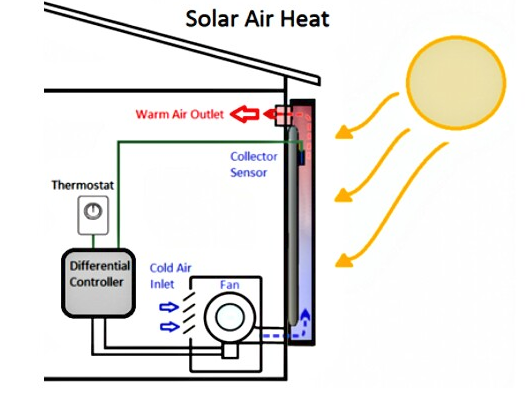
V. Solar Process Flow

1. Light hits your roof’s solar panels with photons (particles of sunlight)
2. Solar panel converts those photons into electrons of Direct Current (DC) electricity
- Electrons flow out of the solar panel and intro an inverter and other electrical safety devices
3. The inverter converts the DC power (commonly used in batteries) into alternating current or AC power
- A net energy meter keeps track of all the power your solar panel produces
4. AC power is the kind of electrical that your TV, computer, and toasters use when plugged into the wall outlet
5. Any solar energy that you do not use simultaneously with production will go back into the electrical grid through the meter
- At night or on cloudy days, when your system is not producing more than your building needs, you will consume electricity from the grid as normal
- Your utility bill will bill you for the “net” consumption for any given billing period and provide you with a dollar credit for any excess during a given period
VI. Incorporating PV systems into your home and business
- Can be blended easily into both traditional and nontraditional homes, powering appliances, and electric systems
- PV cells can be installed as a standalone module that is attached to your roof or on a separate system, or using integrated roofing materials with dual functions.
- The most common practice is to mount modules onto a south facing roof or wall
- PV systems likewise can be blended into virtually every conceivable structure for commercial buildings
- You’ll find PV used outdoors for security lighting as well as in structures that serve as covers for parking lots and bus shelter
VII. Solar energy consumption and storage
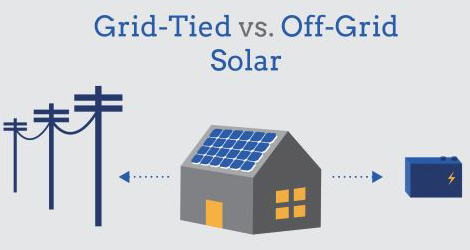
1. Grid tie solar system
- The electricity produce will be fed directly back into your local power grid. When you are producing electricity, any energy you consume will come directly from your solar system and any excess will go back into the grid
2. Off-grid solar system
- Your system will have a rechargeable battery in the loop, right after the inverter. This battery is charged by your solar cells and stores any excess energy, which guarantees that you will always be using the energy you generate yourself, and that you’ll always have energy as long as you produce sufficient amounts.
In the next chapter we’ll discuss about how Blockchain could transform the Renewable Energy Industry….
Hi! I am a robot. I just upvoted you! I found similar content that readers might be interested in:
https://www.altestore.com/howto/components-for-your-solar-panel-photovoltaic-system-a82/
Thank you very much for such a detailed article about. how solar energy works from and to. Now I understand why and why all this is necessary. Finally, now I will use https://www.renogy.com/inverters/inverter-chargers/ . I didn't know for a long time when I would need to buy an inverter. Thank you again!
Good day. Focused on providing affordable energy solutions to its customers, evergy offers competitive rates and works with customers to find ways to reduce their energy costs. Evergy also offers energy efficiency programs and rebates to help customers save on their energy bills. By offering affordable energy solutions, Evergy helps customers reduce energy costs and improve their financial well-being, and all of their customers value this and support the company in every possible way.
Solar energy, a beacon of hope in the quest for sustainable power, holds the key to shaping our future. With the sun's abundance, harnessing its rays offers a path to cleaner, greener energy. Embracing solar technology not only reduces our carbon footprint but also unlocks economic opportunities and energy independence. As we navigate towards a brighter tomorrow, let's seize the potential of solar power and go now, towards a more sustainable and resilient energy future.
Solar energy is transforming how we meet global energy demands, offering a clean, renewable alternative to fossil fuels. Among the latest advancements, flexible solar panels are paving the way for innovative applications. These lightweight and adaptable panels can be integrated into everyday objects, from backpacks to building materials, making solar power more accessible. With their durability and efficiency, flexible solar panels are unlocking new possibilities, ensuring solar energy becomes a cornerstone of sustainable living and a brighter, greener future for all.
Solar energy is one of the easiest ways to make your home more sustainable. It's exciting to see more communities adopting it!